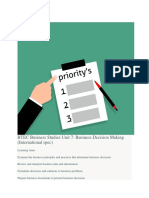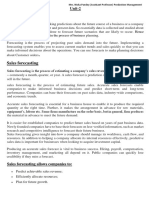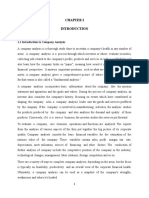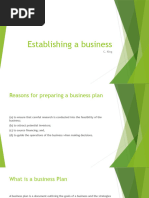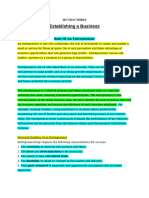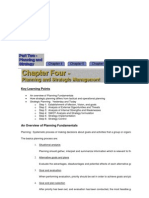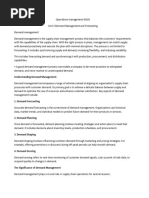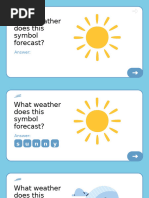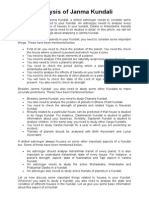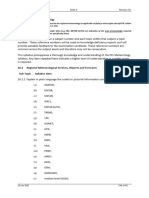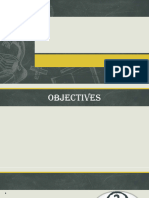0 ratings0% found this document useful (0 votes)
15 viewsOutline For Today: Definition of Forecasting Elements of Forecsting Significance of Forecasting
Outline For Today: Definition of Forecasting Elements of Forecsting Significance of Forecasting
Uploaded by
Siddharth MohapatraDemand forecasting is a scientific approach to anticipating future demand for a product based on past trends, data, and related events. It allows organizations to plan production, purchasing, funds, and prices. A good forecast is timely, accurate, reliable, expressed meaningfully, and in writing. Forecasting involves preparing by studying the company, market, and industry; establishing future expectations with key personnel; comparing actual to estimated results; and refining forecasts based on deviations. Forecasting helps fulfill objectives, prepare budgets, stabilize employment and production, expand organizations, make management decisions, evaluate performance, and help governments plan trade. Steps in forecasting include determining objectives, items to forecast, time horizon, models, gathering data, validating models,
Copyright:
© All Rights Reserved
Available Formats
Download as PPTX, PDF, TXT or read online from Scribd
Outline For Today: Definition of Forecasting Elements of Forecsting Significance of Forecasting
Outline For Today: Definition of Forecasting Elements of Forecsting Significance of Forecasting
Uploaded by
Siddharth Mohapatra0 ratings0% found this document useful (0 votes)
15 views16 pagesDemand forecasting is a scientific approach to anticipating future demand for a product based on past trends, data, and related events. It allows organizations to plan production, purchasing, funds, and prices. A good forecast is timely, accurate, reliable, expressed meaningfully, and in writing. Forecasting involves preparing by studying the company, market, and industry; establishing future expectations with key personnel; comparing actual to estimated results; and refining forecasts based on deviations. Forecasting helps fulfill objectives, prepare budgets, stabilize employment and production, expand organizations, make management decisions, evaluate performance, and help governments plan trade. Steps in forecasting include determining objectives, items to forecast, time horizon, models, gathering data, validating models,
Original Title
6- (27th july)
Copyright
© © All Rights Reserved
Available Formats
PPTX, PDF, TXT or read online from Scribd
Share this document
Did you find this document useful?
Is this content inappropriate?
Demand forecasting is a scientific approach to anticipating future demand for a product based on past trends, data, and related events. It allows organizations to plan production, purchasing, funds, and prices. A good forecast is timely, accurate, reliable, expressed meaningfully, and in writing. Forecasting involves preparing by studying the company, market, and industry; establishing future expectations with key personnel; comparing actual to estimated results; and refining forecasts based on deviations. Forecasting helps fulfill objectives, prepare budgets, stabilize employment and production, expand organizations, make management decisions, evaluate performance, and help governments plan trade. Steps in forecasting include determining objectives, items to forecast, time horizon, models, gathering data, validating models,
Copyright:
© All Rights Reserved
Available Formats
Download as PPTX, PDF, TXT or read online from Scribd
Download as pptx, pdf, or txt
0 ratings0% found this document useful (0 votes)
15 views16 pagesOutline For Today: Definition of Forecasting Elements of Forecsting Significance of Forecasting
Outline For Today: Definition of Forecasting Elements of Forecsting Significance of Forecasting
Uploaded by
Siddharth MohapatraDemand forecasting is a scientific approach to anticipating future demand for a product based on past trends, data, and related events. It allows organizations to plan production, purchasing, funds, and prices. A good forecast is timely, accurate, reliable, expressed meaningfully, and in writing. Forecasting involves preparing by studying the company, market, and industry; establishing future expectations with key personnel; comparing actual to estimated results; and refining forecasts based on deviations. Forecasting helps fulfill objectives, prepare budgets, stabilize employment and production, expand organizations, make management decisions, evaluate performance, and help governments plan trade. Steps in forecasting include determining objectives, items to forecast, time horizon, models, gathering data, validating models,
Copyright:
© All Rights Reserved
Available Formats
Download as PPTX, PDF, TXT or read online from Scribd
Download as pptx, pdf, or txt
You are on page 1of 16
Dt.
27th july 2020
SUB-S&OP
Ananta Prasad Nanda
Associate Prof.(OM)
Outline For Today:
Definition of forecasting
Elements of forecsting
Significance of forecasting
FORECASTING:
Forecasts are becoming the lifetime of business in a
world, where the tidal waves of change are sweeping the
most established of structures, inherited by human society.
Survival in this age of economic predators, requires the
tact, talent and technique of predicting the future.
It refers to a scientific and creative approach for
anticipating the demand /sales of a particular commodity
in the market based on past behaviour, experience, data
and pattern of related events. It is not based on mere
guessing or prediction but is backed up by evidence and
past trends.
Cont…….
Demand forecasting enables an organization to
take various business decisions, such as planning
the production process, purchasing raw materials,
managing funds, and deciding the price of the
product. An organization can forecast demand by
making own estimates called guess estimate or
taking the help of specialized consultants or
market research agencies
Elements Of a Good Forecast:
The forecast should be timely. ...
The forecast should be accurate, and the degree
of accuracy should be stated. ...
The forecast should be reliable; it should work
consistently. ...
The forecast should be expressed in meaningful
units. ...
The forecast should be in writing.
J.W. Redfield describes the following elements of
forecasting process:
1. Prepare the groundwork.
2. Establishing future business.
3. Comparing actual with estimated results.
4. Refining the forecasts.
1. Prepare the Groundwork:
The group work preparation requires a thorough
study, investigation and analysis of the company, its
products, its market share, its organisational structure
and the industry. The investigation will involve the
past performance of all these factors, their growth
over a period of time and the extent of their inter-
relationships and inter-dependence. The aim is to
build a foundation on which future estimates can be
based.
2. Establishing Future Business:
The future expectancy of the business can be
reasonably computed from the past data as well as
the input from the key executives of the organisation,
sales personnel and other specialists.
This forecast is developed with the participation of
the key personnel and is officially communicated to
all. Thus all these people assume responsibility for
meeting these forecasts and accountability for any
deviations from this forecast.
3. Comparing Actual with Estimated Results:
The forecast estimates over the future years provide
benchmarks against which the actual growth and
results can be measured and compared. If there are
significant variations between the two, one way or
another, the reasons for such deviations can be
investigated and analysed.
4. Refining the Forecasts:
In the light of any deviations found, the forecast can
be refined to be more realistic. If some conditions have
changed during the periodic evaluation, then the new
values of the variables can be incorporated in the
estimates.
Significance of Demand Forecasting:
Demand plays a crucial role in the management of
every business. It helps an organization to reduce risks
involved in business activities and make important
business decisions. Apart from this, demand
forecasting provides an insight into the organization’s
capital investment and expansion decisions
i. Fulfilling objectives:
Implies that every business unit starts with certain
pre-decided objectives. Demand forecasting helps in
fulfilling these objectives. An organization estimates
the current demand for its products and services in the
market and move forward to achieve the set goals.
For instance, an organization has set a target of
selling 50, 000 units of its products. In such a case, the
organization would perform demand forecasting for its
products. If the demand for the organization’s products
is low, the organization would take corrective actions,
so that the set objective can be achieved
ii. Preparing the budget:
Plays a crucial role in making budget by estimating
costs and expected revenues.
For instance, an organization has forecasted that the
demand for its product, which is priced at Rs. 10,
would be 1,00,000 units. In such a case, the total
expected revenue would be 10* 100000 = Rs. 10, 00,
000.
In this way, demand forecasting enables
organizations to prepare their budget.
iii. Stabilizing employment and production:
Helps an organization to control its production and
recruitment activities. Producing according to the
forecasted demand of products helps in avoiding the
wastage of the resources of an organization. This
further helps an organization to hire human resource
according to requirement.
For instance, if an organization expects a rise in the
demand for its products, it may opt for extra labor to
fulfill the increased demand.
iv. Expanding organizations:
Implies that demand forecasting helps in deciding
about the expansion of the business of the
organization. If the expected demand for products is
higher, then the organization may plan to expand
further. On the other hand, if the demand for products
is expected to fall, the organization may cut down the
investment in the business.
For instance,covid-19
v. Taking Management Decisions:
Helps in making critical decisions, such as
deciding the plant capacity, determining the
requirement of raw material, and ensuring the
availability of labor and capital.
vi. Evaluating Performance:
Helps in making corrections.
For instance, if the demand for an organization’s
products is less, it may take corrective actions and
improve the level of demand by enhancing the
quality of its products or spending more on
advertisements.
vii. Helping Government:
Enables the government to coordinate import and
export activities and plan international trade.
STEPS USED IN FORECASTING SYSTEM:
Determine the objective of forecast.
Identify items to be forecast
Determine the time horizon
Select the forecasting model(s).
Gather data(s).
Validate the model.
Makes forecast and implement result.
You might also like
- BTEC L3, Unit 7 - Business Decision Making NotesDocument41 pagesBTEC L3, Unit 7 - Business Decision Making NotesJoy100% (1)
- Atp 45 (D) PDFDocument450 pagesAtp 45 (D) PDFKerry O'Connell0% (1)
- Examen MeteorologiaDocument185 pagesExamen MeteorologiaYuvaraj UdayagiriNo ratings yet
- 103 EADB Chapter-2: Dr. Rakesh BhatiDocument85 pages103 EADB Chapter-2: Dr. Rakesh BhatiDr. Rakesh BhatiNo ratings yet
- OM Note FNLDocument16 pagesOM Note FNLMotuma AbebeNo ratings yet
- ForecastingDocument8 pagesForecastingwaloranttr8No ratings yet
- Demand ForecastingDocument6 pagesDemand Forecastingiqra sarfarazNo ratings yet
- Demand Forecasting: Concept, Significance, Objectives and FactorsDocument24 pagesDemand Forecasting: Concept, Significance, Objectives and FactorsXinger XingerNo ratings yet
- Demand ForecastingDocument15 pagesDemand Forecastinggoelvansh636No ratings yet
- BTTM Ordinance and Course Curriculum Final 2015Document9 pagesBTTM Ordinance and Course Curriculum Final 2015surya pratap singhNo ratings yet
- W2 Module 2 - Demand Forecasting PresentationDocument16 pagesW2 Module 2 - Demand Forecasting PresentationDanica VetuzNo ratings yet
- Eco Chap 2Document27 pagesEco Chap 2Darsani SelvarajNo ratings yet
- Demand Forecasting Written Report PDFDocument35 pagesDemand Forecasting Written Report PDFSheridanne GiloNo ratings yet
- demand Forecasting.docxDocument9 pagesdemand Forecasting.docxAnuvika AnuNo ratings yet
- Que:-Explain The Concept of Demand Forecasting With The Help of An ExampleDocument7 pagesQue:-Explain The Concept of Demand Forecasting With The Help of An ExampleTanvi AnandNo ratings yet
- Lesson 2 - Module 002 Demand ForecastingDocument16 pagesLesson 2 - Module 002 Demand ForecastingNoe AgubangNo ratings yet
- Production ForcastingDocument29 pagesProduction Forcastingbabita_27No ratings yet
- Demand ForecastingDocument8 pagesDemand ForecastingSubhankar PandaNo ratings yet
- FORECASTINGDocument11 pagesFORECASTINGjunryvalmorida18No ratings yet
- Assignment Nos. 5 Estimating and Forecasting DemandDocument3 pagesAssignment Nos. 5 Estimating and Forecasting DemandKeziaNo ratings yet
- Demand ForecastingDocument45 pagesDemand ForecastingGopal SakiaNo ratings yet
- Demand Forecasting SourcesDocument9 pagesDemand Forecasting Sourcesrachita yedhulaNo ratings yet
- SMSCDocument8 pagesSMSCTanya AnandNo ratings yet
- Reaction Paper Forecasting and Demand PlanningDocument1 pageReaction Paper Forecasting and Demand PlanningJeddcedric RempilloNo ratings yet
- Demand ForecastingDocument36 pagesDemand Forecastingkcdelacruz.knowledgeNo ratings yet
- 1) Mission Statement: InternallyDocument3 pages1) Mission Statement: InternallyrNo ratings yet
- 1) Mission Statement: InternallyDocument4 pages1) Mission Statement: InternallyrNo ratings yet
- Lesson 10Document8 pagesLesson 10eliagracechellemaeNo ratings yet
- Importance of Financial PlanningDocument18 pagesImportance of Financial PlanningSyam LaNo ratings yet
- Chapter 2, Ab 21Document25 pagesChapter 2, Ab 21Cynthia Marie TadeoNo ratings yet
- Laran Written Report Ba106Document22 pagesLaran Written Report Ba106Jessuel Larn-epsNo ratings yet
- BBE4102 Quiz 2 - NacionalesDocument2 pagesBBE4102 Quiz 2 - NacionalesedrianclydeNo ratings yet
- HRM Ass 4Document6 pagesHRM Ass 4Mabvuto PhiriNo ratings yet
- Business ForecastingDocument11 pagesBusiness ForecastingM F HussainNo ratings yet
- Shikhar Insurance Part 1 New 1 PDFDocument22 pagesShikhar Insurance Part 1 New 1 PDFRupak GautamNo ratings yet
- Chapter 3: Forecasting: Learning InsightDocument3 pagesChapter 3: Forecasting: Learning InsightJoey RosalesNo ratings yet
- ForecastingDocument69 pagesForecastingSHENUNo ratings yet
- Lesson 3Document32 pagesLesson 3shinichik153No ratings yet
- Entrepreneurship DA 1Document13 pagesEntrepreneurship DA 1Pushpa MahatNo ratings yet
- Production Management-Unit-2 (NOTES) BBA203Document9 pagesProduction Management-Unit-2 (NOTES) BBA203Divya MishraNo ratings yet
- ESBM Notes Unit-4Document37 pagesESBM Notes Unit-4satyamtiwari44003No ratings yet
- Mainbody Shikhar-InsuranceDocument28 pagesMainbody Shikhar-InsuranceBadri mauryaNo ratings yet
- Untitled DocumentDocument3 pagesUntitled DocumentAyisa DaramolaNo ratings yet
- Operation Management Answers-1Document27 pagesOperation Management Answers-1Manish PRAKASH (EA2252001010405)No ratings yet
- Business EconomicsDocument9 pagesBusiness EconomicsHarsh BallavNo ratings yet
- Unit IIDocument54 pagesUnit IIgiridharNo ratings yet
- Entrep 2 Grade 10Document12 pagesEntrep 2 Grade 105yddqkhzbbNo ratings yet
- Business Environment Unit 4Document8 pagesBusiness Environment Unit 4Kainos GreyNo ratings yet
- BUS 311 Recognising and Exploiting Business OpportunitiesDocument5 pagesBUS 311 Recognising and Exploiting Business OpportunitiesAdeleye AdetunjiNo ratings yet
- Business Finance ConceptDocument55 pagesBusiness Finance ConceptBir MallaNo ratings yet
- SECTION 3Document13 pagesSECTION 3nathan.simpson0515No ratings yet
- Unit 5: Growing New VentureDocument8 pagesUnit 5: Growing New VentureMezmure KebedeNo ratings yet
- Pinoy Entrepreneurial Charateristics and Business Studies: Topic 6Document61 pagesPinoy Entrepreneurial Charateristics and Business Studies: Topic 6Antonio Mark AnthonyNo ratings yet
- Strategic Management and Business Policy Critical Chapter ReviewDocument13 pagesStrategic Management and Business Policy Critical Chapter ReviewEdlamu Alemie100% (2)
- Ide AssignmentDocument6 pagesIde AssignmentVaishnav . K JNo ratings yet
- Unit-4 Managed EconomicsDocument29 pagesUnit-4 Managed Economicsnewnotion4No ratings yet
- Accounting and FinanceDocument17 pagesAccounting and FinanceltfmiahNo ratings yet
- Chapter 1Document7 pagesChapter 1Sunny YadavNo ratings yet
- Robinbust 222Document24 pagesRobinbust 222robin wanjalaNo ratings yet
- BcgmatrixDocument16 pagesBcgmatrixRanjana TrivediNo ratings yet
- Operations Management M103 Unit 2Document24 pagesOperations Management M103 Unit 2Harshit PathakNo ratings yet
- SCML MCQDocument15 pagesSCML MCQSiddharth Mohapatra100% (1)
- Supply Chain Management & Logistics (SCML) : Department of Operation ManagementDocument58 pagesSupply Chain Management & Logistics (SCML) : Department of Operation ManagementSiddharth MohapatraNo ratings yet
- Work Life BalanceDocument10 pagesWork Life BalanceSiddharth MohapatraNo ratings yet
- Underwriters of Some Biggest IpoDocument3 pagesUnderwriters of Some Biggest IpoSiddharth MohapatraNo ratings yet
- Operations Strategymod1Document209 pagesOperations Strategymod1Siddharth MohapatraNo ratings yet
- Characteristics of Effective Writing Characteristics of Effective WritingDocument16 pagesCharacteristics of Effective Writing Characteristics of Effective WritingSiddharth MohapatraNo ratings yet
- Business MemosDocument9 pagesBusiness MemosSiddharth MohapatraNo ratings yet
- OB-Personality and Perception NotesDocument26 pagesOB-Personality and Perception NotesSiddharth MohapatraNo ratings yet
- The Reading Skill FinalDocument21 pagesThe Reading Skill FinalSiddharth MohapatraNo ratings yet
- Biju Patnaik Institute of IT & Management Studies, BhubaneswarDocument31 pagesBiju Patnaik Institute of IT & Management Studies, BhubaneswarSiddharth MohapatraNo ratings yet
- MP NotesDocument162 pagesMP NotesSiddharth MohapatraNo ratings yet
- Production and Cost AnalysisDocument140 pagesProduction and Cost AnalysisSiddharth MohapatraNo ratings yet
- Module 3Document43 pagesModule 3Siddharth MohapatraNo ratings yet
- Preparation of Business PlanDocument13 pagesPreparation of Business PlanSiddharth MohapatraNo ratings yet
- Module 2.4 - MotivationDocument17 pagesModule 2.4 - MotivationSiddharth MohapatraNo ratings yet
- Business Ethics: Prof.S.B.MishraDocument32 pagesBusiness Ethics: Prof.S.B.MishraSiddharth MohapatraNo ratings yet
- Golden Premier Saver: (Online)Document12 pagesGolden Premier Saver: (Online)Siddharth MohapatraNo ratings yet
- Share Capital: Ms. Anjali Prava Mishra Asst. Prof in Finance BiitmDocument25 pagesShare Capital: Ms. Anjali Prava Mishra Asst. Prof in Finance BiitmSiddharth MohapatraNo ratings yet
- Module-3 Queuing TheoryDocument8 pagesModule-3 Queuing TheorySiddharth MohapatraNo ratings yet
- LAS SHS DRRR MELC 8 Q2 Week-3Document9 pagesLAS SHS DRRR MELC 8 Q2 Week-3Atalanta LeeNo ratings yet
- Weather-at-its-Worst JessDocument36 pagesWeather-at-its-Worst JessYuri YuriNo ratings yet
- DLL - Science 3 - Q4 - W3Document2 pagesDLL - Science 3 - Q4 - W3O Jenra K EithNo ratings yet
- Listado de Verbos Con 3era Persona SingularDocument14 pagesListado de Verbos Con 3era Persona SingularKarem ArosticaNo ratings yet
- Stability TestingDocument3 pagesStability TestingSebabrata Ghosh DastidarNo ratings yet
- Ways of Expressing Future Grammar Drills Sentence Transformation Rephrasing - 115958Document2 pagesWays of Expressing Future Grammar Drills Sentence Transformation Rephrasing - 115958Ali FetohNo ratings yet
- Importance of ForecastingDocument37 pagesImportance of ForecastingFaizan TafzilNo ratings yet
- On The Global Observing System: ManualDocument51 pagesOn The Global Observing System: ManualsumdinNo ratings yet
- Tidal HeightsDocument4 pagesTidal HeightsMohamed Noor AhamedNo ratings yet
- Final Test Activate A2Document4 pagesFinal Test Activate A2MelisaB.RiveroNo ratings yet
- Future Forms: Task 1. Read and MatchDocument4 pagesFuture Forms: Task 1. Read and Matchlala LachimoNo ratings yet
- Weather Report Project AbstractDocument1 pageWeather Report Project AbstractSomething To Know0% (2)
- Lesson 6-Sales ForecastingDocument33 pagesLesson 6-Sales ForecastingTewelde AsefaNo ratings yet
- Club Francais Du VinDocument6 pagesClub Francais Du VinAkanksha SharmaNo ratings yet
- Humss ADocument20 pagesHumss AMaricel Ceyh GonzalesNo ratings yet
- Northern Hemisphere: Weather & Climate Over Major Crop AreasDocument36 pagesNorthern Hemisphere: Weather & Climate Over Major Crop AreasDedy SuryawanNo ratings yet
- Facts For Planets Extra Credit With ChrisDocument2 pagesFacts For Planets Extra Credit With Chrisapi-205296401No ratings yet
- Assessing The Strength of Reinforced Concrete Structures Through Ultrasonic Pulse Velocity and Schmidt Rebound Hammer Tests-LibreDocument8 pagesAssessing The Strength of Reinforced Concrete Structures Through Ultrasonic Pulse Velocity and Schmidt Rebound Hammer Tests-LibremingNo ratings yet
- Analysis of Janma KundaliDocument2 pagesAnalysis of Janma Kundalirahul106No ratings yet
- Online TESOL - Online TEFL ITTT Answers - Unit 8Document6 pagesOnline TESOL - Online TEFL ITTT Answers - Unit 8helina.kasturiNo ratings yet
- 5-Day Weather Forecast Valid 20th To 24th April 2024Document3 pages5-Day Weather Forecast Valid 20th To 24th April 2024Shruti DhanjalNo ratings yet
- Alvin Toffler: His IdeasDocument3 pagesAlvin Toffler: His IdeasUshma DesaiNo ratings yet
- Abu Dhabi Water and Electricity Company Project ReportDocument9 pagesAbu Dhabi Water and Electricity Company Project ReportKevin KevinNo ratings yet
- Casio Manual, Operation Guide 2894Document0 pagesCasio Manual, Operation Guide 2894cboutsNo ratings yet
- CPL Meteorology SyllabusDocument15 pagesCPL Meteorology SyllabusBhavesh GoelNo ratings yet
- Week 2 SCI1Document60 pagesWeek 2 SCI1hadesramos403No ratings yet
- Group - 9 - SADMAN B - WILKINS, A ZURN COMPANYDocument10 pagesGroup - 9 - SADMAN B - WILKINS, A ZURN COMPANYOM PRAKASH MALLIKNo ratings yet
- Mechanism Producing PrecipitationDocument3 pagesMechanism Producing PrecipitationUmar100% (1)
